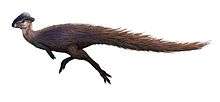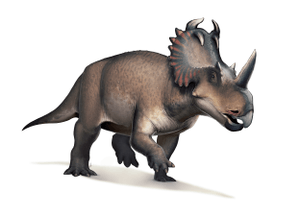Platyceratops
Platyceratops is a genus of ceratopsian dinosaur from the Late Cretaceous of Mongolia. It lived during the Campanian stage, about 75-72 million years ago. The name Platyceratops is derived from Greek, and means "flat horned face". Platyceratops is similar to Bagaceratops, although its skull is larger. It has been referred to the Bagaceratopidae or at least the Neoceratopsia. It is possibly a junior synonym of Bagaceratops.[1] The type species is Platyceratops tatarinovi, described by Alifanov in 2003.
| Platyceratops | |
|---|---|
| Scientific classification | |
| Kingdom: | Animalia |
| Phylum: | Chordata |
| Clade: | Dinosauria |
| Order: | †Ornithischia |
| Family: | †Bagaceratopidae |
| Genus: | †Platyceratops Alifanov, 2003 |
| Species | |
|
Platyceratops tatarinovi Alifanov, 2003 type | |
Classification
Platyceratops belonged to the Ceratopsia (the name is Greek for "horned face"), a group of herbivorous dinosaurs with parrot-like beaks that thrived in North America and Asia during the Cretaceous Period. The validity of Platyceratops remains in doubt. Both Platyceratops and Bagaceratops were found at the same locality, the Red Beds at Khermeen Tsav, which raises the possibility that they are in fact the same species.[1]
Diet
Platyceratops, like all ceratopsians, was a herbivore.
See also
References
- V. R. Alifanov. 2003. Two new dinosaurs of the infraorder Neoceratopsia (Ornithischia) from the Upper Cretaceous of the Nemegt Depression, Mongolian People's Republic. Paleontological Journal 37(5):524-534.
- Makovicky, Peter J.; Norell, Mark A. (2006). "Yamaceratops dorngobiensis, a new primitive ceratopsian (Dinosauria: Ornithischia) from the Cretaceous of Mongolia" (pdf). American Museum Novitates. 3530: 1–42. doi:10.1206/0003-0082(2006)3530[1:YDANPC]2.0.CO;2.


